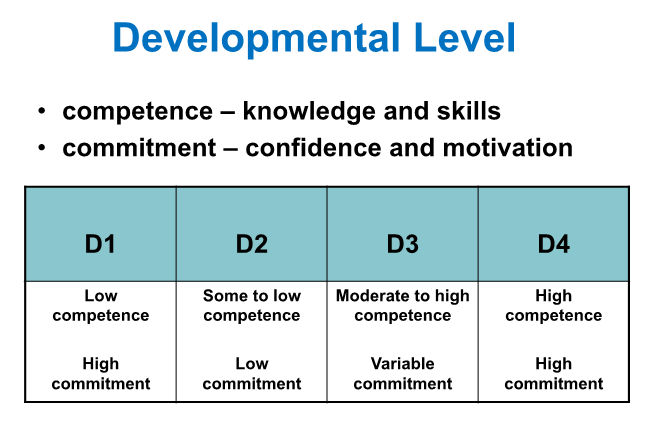Situational Leadership
Situational Leadership Theory is a theory developed by leadership consultants Paul Hersey and Ken Blanchard. The fundamental underpinning of the situational leadership theory is that there is no single "best" style of leadership. Effective leadership is task-relevant, and the most successful leaders are those that adapt their leadership style to the development level of the individual or group they are attempting to lead or influence. Effective leadership varies, not only with the person or group that is being influenced, but it also depends on the task, job or function that needs to be accomplished.
Ability to be directive and/or supportive depending on the situation and the developmental level of the follower
Depends on: degree of urgency AND Level of competence & commitment
Situational Leadership Behaviours
Directive Behaviours:
Set SMART goals for staff
Show and tell how
Establish timelines
Identify priorities
Clarify roles
Develop action plans
Monitor performance closely
Supportive Behaviours
Listen to concerns
Facilitate problem solving
Ask for input
Explain 'why'
Acknowledge and encourage
Share information about organisation
Share information about self
Development Levels
Blanchard’s Situational Leadership® II Model uses the terms “competence” (ability, knowledge, and skill) and “commitment” (confidence and motivation) to describe different levels of development. The Situational Leadership® II Model tends to view development as an evolutionary progression meaning that when individuals approach a new task for the first time, they start out with little or no knowledge, ability or skills, but with high enthusiasm, motivation, and commitment. Blanchard views development as a process as the individual moves from developing to developed, in this viewpoint it is still incumbent upon the leader to diagnose development level and then use the appropriate leadership style.
Developing people and self-motivation
A good leader develops “the competence and commitment of their people so they’re self-motivated rather than dependent on others for direction and guidance.” According to Hersey's 'The Situational Leader", the leader’s high, realistic expectation causes high performance of followers; the leader’s low expectations lead to low performance of followers. According to Ken Blanchard, "Four combinations of competence and commitment make up what we call 'development level.'"
A leader needs to motivate followers. In the Blanchard SLII Model, the belief is that an individual comes to a new task or role with low competence (knowledge and transferable skills) but high commitment. As the individual gains experience and is appropriately supported and directed by their leader they reach Development Level 2 and gain some competence, but their commitment drops because the task may be more complex than the individual had originally perceived when they began the task. With the direction and support of their leader, the individual moves to Development Level 3 where competence can still be variable—fluctuating between moderate to high knowledge, ability and transferable skills and variable commitment as they continue to gain mastery of the task or role. Finally, the individual moves to Level 4 where competence and commitment are high.
The Blanchard Situational Leadership II Model rests on two fundamental concepts: (1) leadership style and (2) the individual or group's developmental level.


